
* Corresponding author
E-mail address:hamadk.hadrawi@uokufa.edu.iq (H. K. Hadrawi)
© 2019 by the authors; licensee Growing Science, Canada
doi: 10.5267/j.uscm.2018.7.003
Uncertain Supply Chain Management 7 (2019) 341–350
Contents lists available at GrowingScience
Uncertain Supply Chain Management
homepage: www.GrowingScience.com/uscm
The impact of firm supply performance and lean processes on the relationship between supply
chain management practices and competitive performance
Hamad Karem Hadrawia*
aAssistant Professor, Faculty of Administration and Economics, University of Kufa, Najaf Governorate, Iraq
C H R O N I C L E A B S T R A C T
Article history:
Received February 16, 2018
Accepted July 26 2018
Available online
July 27 2018
The primary objective of the present paper is to explore the link between supply logistic
integration, competitive performance, lean process and supply performance. To achieve our
research objectives, we develop a unique model, which conceptualizes the said relationship.
Porter’s value chain and the resource based views are used as theatrical lenses of the current
study using Amos software package based on a data set of 220 Iraqi manufacturing firms.
Structural equation modeling (SEM) is employed to analyze the dataset. The findings of the
study show that the there was a positive relationship between supply logistics and competitive
performance (operational) and supply performance and lean processes were partially mediating
this relationship. The study also shows the importance of managing both internal (production
processes) and external processes (logistics and supply chain) of firms’ operations in an
integrated manner in which supply chain management acts through key internal processes to
impact competitive performance. This is the first study, which uncovers what happens “in
between” the incoming materials and the end outputs delivered by firms into the market. This
“in between black box” is important in improving our understanding of how inbound supply
activities are translated into outbound competitive performance outcomes.
ensee Growin
g
Science, Canada© 2018 b
y
the authors; lic
Keywords:
Iraq
Supply Chain
Competitive Performance
1. Introduction
Supply chain management practices (SCMP) circumscribe perspectives and practices that effectively
help all suppliers, manufacturers, distributors, and consumers achieve their long-term performance
objectives (Hugos, 2018). Vonderembse et al. (2006) explained three products cantered supply chains
which are standard products with minimal differentiation, innovative products with high differentiation
and hybrid products with a moderate level of differentiation. They further argued that standard products
in simple forms should be produced using lean supply chain, which emphasizes on continuous
improvement and waste reduction, the innovative product with technologically complex should be
produced by agile supply chain and hybrid products with many suppliers should be produced by the
hybrid supply chain. Information sharing is the key for supply chain integration; where the information
sharing organizations can be more responsive towards ever-changing consumer needs.

342
SCM sets of actions carried by an organization to improve the flow of information and goods among
all stakeholders. The up to date concept of SCM advocates partnership with a supplier, outsourcing,
and reduction of cycle time, uninterrupted flow of information and continuous sharing of technology.
In this study, SCM practices are managerial activities which are executed to improve organizational
supply chain performance (Sufian & Habibullah, 2010). The global supply chain forum has declared
supply chain a strategically integrated network rather than a simple chain relationship and defines it as
SCMP which is the “integration of key business processes from end user through original suppliers that
provides products, services and information that add value for customers and other stakeholders”.
Choon Tan et al. (2002) also presented a similar definition and defined SCM as “an integrated approach
of purchase and logistics management”. Shadur and Bamber (1994) defined SCM as “a function of
customer delivery, inventory management, lean strategy and strategic integration”.
On time delivery is one of the most important determinants of delivery performance (Anand & Grover,
2015) and according to Gelders et al. (1994), delivery time is a measure of customer satisfaction and
helps in conceptualizing the link between organizational operations and delivery channels. Botha et al.
(2017) found a positive relationship between delivery performance and supply chain performance and
explored order fill lead time, delivery to request date order fill lead time and delivery to commit date
as an important measure of delivery performance which is central to supply chain performance.
Goods in transit also place great influence on delivery performance, higher goods in transit due to slow
vehicles, delivery frequency, and location reduce inventory turnover and increase the level of tying up
capital. Delivers flexibility and minimum flows in invoices are also determinants of delivery
performance (Anand & Grover, 2015). During the recent days, delivery system has become more
flexible than earlier, the introduction of strategies like cross doc and delivery performance measuring
tools has made it subject of strategic management.
Customer satisfaction is at the heart of every supply chain strategy, no performance measurement is
possible without taking into account the customer satisfaction (Gunasekaran & Kobu, 2007; Anand &
Grover, 2015). Product design, delivery methods, and the feedbacks should be integrated with customer
requirements.
Production flexibility is another determinant of a successful supply chain. A flexible supply chain is
the one, which has the ability to respond ever-changing market demand, customer needs and can offer
products with various specifications, i.e. features, options i.e. color size, etc. (Vanichchinchai, 2014;
Vanichchinchai & Igel, 2011). As with increasing environmental uncertainty and diversity companies
are using supply chain as a strategic tool to gain a competitive advantage, flexibility can be seen as the
key dimension of the SCMP. More broadly, flexibility can be seen as the firms’ ability to adjust or
respond to ever-changing environmental factors i.e. market demand and customer needs.
Ever-changing customer needs have become one of the biggest threats in today’s competitive business
world. In a postmodern business era, because of seventy plus years of marketing, customers are now
well aware of product features and related requirements. Technology has become a major threat;
consumer needs are continually changing and they need products to satisfy their unique needs as well.
If a firm fails in understanding or accessing, changing customer’s needs, then we should expect the
competitors will win.
In the manufacturing sector, which offers both generic goods i.e. clothing and griffin goods i.e. fashion,
changing customer need is a continuous threat, in such case firm needs to abruptly switch from current
product to another one, either with a significant change in current product or with entirely a new
product.This switch or more comprehensively the efficiency of this switch is entirely based on the
flexibility of supply chain i.e. if a supply chain is flexible enough to cope this change than firm will be
able to get a sustainable competitive advantage, otherwise it will lose its market share.
The studies carried out by Vanichchinchai et al. (2014) and Vanichchinchai and Igel (2011) focused on
the relationship between total quality management SCMP and firm supply performance. The “Cost
(CT), Flexibility (FL), Relationship (RL) and Responsiveness (RS)” were used as dimensions of a

H. K. Hadrawi / Uncertain Supply Chain Management 7 (2019)
343
success full supply chain. The findings suggest that total quality management (TQM) has a direct
positive effect on firm supply performance as well as indirect through SCM. The primary data of the
study carried out by Vanichchinchai and Igel. (2011) were gathered from 171 managers of automotive
industry of Thailand and they found a significant relationship between all the components.
To achieve organizational goals i.e. total customer satisfaction, cost savings, and supply chain quality
management can be achieved by successful implementation of supplier relationship management
(SRM); which advocates an integrated network of all suppliers to achieve organizational goals. It
further emphasizes on multiple strategic moves i.e. every supplier and customer is different and cannot
be dealt with a single strategy. Actually, nowadays products and services being placed great influence
on customer or supplier perception about and how the organization views them. To get an optimal yield,
understanding and wisely responding to this triangulation is prerequisite (Gunasekaran & Kobu, 2007).
The importance of SRM can be explained with the fact that, the poor coordination among suppliers has
become one of the major issues in US food industry and is accounted for the waste of almost $30 billion
annually outsourcing constituent 50-60 percent of total product (Sambasivan et al., 2009). Actually
with ever-changing customer demand and to manage and mitigate intense rivalry from existing and
potential competitors, we need a responsive and flexible supply chain which is only possible with the
successful installation of SRM program.
Sodhi and Son (2009) in their vintage paper examined Korean firms with two different perspectives of
partnership one strategic partner performance and other operational partner performance and found
trust, information sharing, joint relationship management asset specific relationship as important
determents of supply chain partner management, they further argued strategic partnership as an
important factor of successful partnership and findings were also consistent with prior findings of
Mentzer et al. (2000) and Lambert et al. (2005). Sodhi and Son (2009) apart from above mentioned
strategic partnership includes trust promoting culture and leadership support. They concluded with a
definition of strategic SCMP and defined it as a function of long-term relationships based on mutual
trust and leadership support. The objective of SCMP is to ensure and secure the benefits of all parties
involved in process and information sharing is used as a medium for it. This highlights the importance
of information technology in SCM.
2. Literature review
There are many agreements on definitions of supply chain management. Kaufman (2002) declared
SCM as “removal of communication barrier and eradication of redundancies as ultimate goals of SCM”.
Later Choon et al. (2002) defined waste reduction, synchronized operation, delivery performance,
quality management, and flexibility in production as SCM goals. Simchi-Levi et al. (2004) also
confirmed Choon et al. (2002) and added customer satisfaction, time cost, warehousing and supplier
relation as the SCM goals in literature.
Hence, in last decades SCM has emerged as an integrated approach, which includes waste reduction,
synchronized operation, delivery performance, quality management, flexibility, customer satisfaction,
time cost, warehousing and long-term supplier relation (Tolossa et al., 2013) to achieve competitive
advantage (Wouters et al., 2009), enhance effectiveness (Janvier-James, 2012). Though supply chain,
collaboration can be operationalized in many forms but according to Holweg et al. (2005), the most
significant and important person is the one to speed up the demand and supply by bringing overall
efficiency in the whole supply chain. But failed or ineffective operationalization of supply chain
collaboration can bring cost inefficiency (Corbett & Tang, 1999).
Supply chain integration effectiveness can be measured by successful integration of all internal and
external supply chain members into a supply chain network with shared strategic vision (Lummus &
Vokurka, 1999). Merely integration is not enough, customer satisfaction, cost reduction, and
sustainable product quality are more important. Sometimes SCM implementation results some failures
(Handfield et al., 2005) and managers and researchers try to find the reasons (Power, 2005).

344
The twenty-first century because of technologically advance production, globally spread mass media
and well aware customers have witnessed an intense competition in response to intense competitive
pressure in the business world, organizations are facing numerous challenges to attain sustainable
competitive advantages. The ultimate goal of all kinds of organizations is to provide a high-quality
product with shortened lead time and high responsiveness to its consumer (Vanichchinchai et al., 2014).
Therefore production flexibility with improved agility level has become an important subject in an
ever-changing market and many companies found outsourcing by decentralizing their production as a
solution to this problem and the focus now is to create virtual enterprises. This shows how information
technology is changing market determinants and management styles. But to meet customer’s need and
come up with the same quality from all outsourced, information sharing among all partners is of great
importance.
In a survey about planning and implementation of SCM initiatives from managers of about 300 firms
which were involved in supply chain related activities, the researchers found planning as strong
determent of managerial activities as 92 % of the managers were planning to implement about two
supply chain initiatives. The explanation of the importance of information management in SCMP is
incomplete without highlighting the emerging paradigm of supply chain design and management. This
emerging paradigm emphasizes on inclusion of advanced information technologies for communication
and data interchange, the complexity of SCM function is also a reason for this concept.
It is clear form world-leading firms like Walmart that SCMP and a subsequent concept of supply chain
performance have become one of the most successful competitive strategies (Estampe et al., 2013;
Vanichchinchai et al., 2014; Vanichchinchai and Igel, 2011). SCMP emphasizes on value addition at
each and every step of product development, it further asks for efficient utilization of resources by each
and every person involved in each and every step of production. This value addition process connects
all the suppliers and users in a chain type structure that’s why it is known as SCMP.
Thomas and Griffin (1996) highlighted the development of SCM as concepts and advocates SCM as
concept of operational of activities i.e. purchasing, distribution, warehousing, procurement and other
supply chain activities are at the most developed stage. SCM as a function of operational activities i.e.
searching for quality goods, purchasing the goods processing the goods, storing the goods and
distribution of goods. But SCM at the strategic level is one of the emerging concepts of operation
management and emphasizes on customer satisfaction via providing a quality product through effective
SCMP.
Supply chain strategy is defined as a set of goals and objectives of firms and its supplier to overcome
competitive market by adding value to business operations (Green et al., 2008). Demand assessment
which includes nature of demand and demand for casting is the first and the most important step in
developing supply chain strategy. According to Sindi and Roe (2017), production flexibility becomes
strong by the introduction of the new products in the market and it is low in the companies with wide
product range in comparison with companies with fewer products in the product range
A performing supply chain is the one which can offer products with various specifications, complex
supply chain and successful in implementing the lean supply chain concept with low cost with
minimum lead time. Qi et al. (2011) worked on the relationship between supply chain strategy and firm
performance and explored a positive relationship with arguments that supply chain strategy enhances
supply chain responsive and increases production flexibility which in turn affects performance. Qi et
al. (2011) indicated some consistency with Melnyk et al. (2010) and Hines (2004) as they also declared
supply chain responsiveness a major determinant of performance.
To achieve supply chain goals, employment of the most appropriate courses of actions is prerequisite
and it should be consistent with firm’s long-term strategies. Leading firms like Toyota and Walmart
use this method to achieve their supply chain goals. But it does not always work, for instance firms like
Barilla Spa and Hewlett-Packard were badly affected by this method in the past. Hsu et al. (2009)

H. K. Hadrawi / Uncertain Supply Chain Management 7 (2019)
345
solved this issue with an argument that these practices should be consistent with supply chain strategies
and goals.
The key SCMP principle can be concluded as; it receives input from suppliers, done value addition and
delivers it to the consumer. For building and maintaining sustainable competitive advantages SCMP or
more broadly an effective SCMP is of extreme importance. Guasekaran et al. (2004) and Sufian and
Habibullah (2010) found that management of key elements of information could play a significant
impact on firm supply performance. Byrd and Davidson (2003) argued that knowledge and information
technology had a significant impact on firm supply performance and with the implementation and
adoption of information technology firm can boost the performance of its supply chain.
To measure supply chain performance, two models have been used predominantly by different people
in supply chain literature
(1) Cost: may include inventory costs and operating costs
(2) Combination of cost and customer responsiveness. This includes inventory costs and operating
costs, flexibility, relationship, activity time and customer responsiveness, and flexibility. These
components have been used as supply chain performance measures either singly or jointly.
Vanichchinchai and Igel (2011) argued cost (CT), flexibility (FL), relationship (RL) and responsiveness
(RS) as dimensions of a successful supply chain.
Cost control is one of the basic measures of firm performance and every firm is striving to provide
quality products at the lowest possible cost. Cost efficiency especially inventory cost is one of the most
important determinants of supply chain performance. Inventory cost holds a significant portion of the
firm total cost. The cost, which includes manufacturing cost, outsourcing cost and delivering cost has
become one of the major competitive force in today’s competitive market (Tatsis et al., 2006).
In all businesses and especially in manufacturing sector, inventory cost is of great importance and firms
introduce new ways and design new strategies to reduce inventory cost. Walmart world leading firm
has achieved this position by innovating an inventory management technique, known as cross doc;
which reduces storage cost and enables firms to offer products at a lowest possible price. The smooth
flow of information and material across the supply chain is a strategic decision and financial
performance of any supply chain cannot be measured without taking into account the total logistics
cost. The decision to a tradeoff between shipping expense and time cost is of acute importance as most
of the time an expensive but speedy shipping saves enough from storage and other inventory costs and
reduces the cost to a competitive level (Gunasekaran & Kobu, 2001). Shipment from longer distances
is a continuous threat to cost management decisions, as it makes inventory level volatile resulting from
very high or low level of inventory which ultimately leads us to high administrative and opportunity
cost.
Current assets other than cash i.e. receivables, inventories are known as supply chain assets (Gopal &
Thakkar, 2012). Optimal utilization of assets in a market with ever-increasing inflation and changing
liquidity has become the major challenge for management. Meanwhile, total cash flow time is highly
affected by asset cost with the turnover. This can be named as cash conversion cycle i.e. time between
the purchase of raw material and collection of cash from the customer (Sambasivan et al., 2009). When
the time of this cycle is determined, it can be related with the profit to get an estimation of return on
investment. It measures the managerial performance too. In the sequel of this return on investment, it
will be highly affected by policies formulated by logistic management e.g. sales will be increased with
good customer services which in turn will increase profits and ultimately will lead us to a higher return
on investment. The financial health of supply chain can be checked with detailed insights into the
impact of ROI in logistics and other areas of the organization.
The introduction of new products in the market is slower from companies with wide product range in
comparison with companies with fewer products in product range (Mapes et al. 1997). A performing
supply chain is the one which can offer products with various specifications with a complex supply

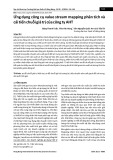
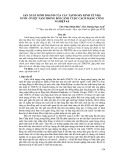
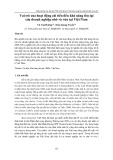
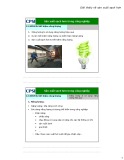


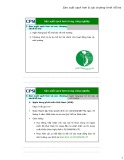

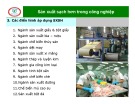



![Tối ưu hóa hiệu suất hệ thống: Bài thuyết trình [Chuẩn nhất]](https://cdn.tailieu.vn/images/document/thumbnail/2025/20251107/hiepdz2703@gmail.com/135x160/35941762488193.jpg)




![Bài giảng Quản trị chất lượng trong công nghiệp thực phẩm [chuẩn nhất]](https://cdn.tailieu.vn/images/document/thumbnail/2025/20250805/vijiraiya/135x160/637_bai-giang-quan-tri-chat-luong-trong-cong-nghiep-thuc-pham.jpg)

![Đề cương bài giảng Kỹ năng hoạt động công nghiệp [mới nhất]](https://cdn.tailieu.vn/images/document/thumbnail/2025/20250715/kimphuong1001/135x160/76971752564028.jpg)


![Bài giảng Kỹ thuật điều độ trong sản xuất và dịch vụ [mới nhất]](https://cdn.tailieu.vn/images/document/thumbnail/2025/20250630/dcbaor/135x160/13121751251866.jpg)


